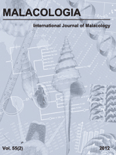
MALACOLOGIA
Scope & Guideline
Unveiling the Secrets of Malacology and Beyond
Introduction
Aims and Scopes
- Taxonomy and Systematics:
A core area of the journal, focusing on the classification, identification, and evolutionary relationships of mollusk species. This includes both contemporary and fossil taxa, providing insights into their phylogeny and biogeography. - Ecology and Behavior:
Research in this area examines the ecological roles of mollusks in various environments, including their interactions with other species, feeding behaviors, and adaptations to different habitats. - Conservation Biology:
The journal emphasizes studies related to the conservation of mollusk species, particularly those that are threatened or endangered. This includes research on habitat preservation, population dynamics, and the impacts of environmental changes. - Genetics and Genomics:
MALACOLOGIA publishes research involving molecular techniques to explore genetic diversity, population structure, and evolutionary processes in mollusks, contributing to a deeper understanding of their biology. - Physiology and Morphology:
This area involves the study of the anatomical and physiological characteristics of mollusks, including adaptations to their environments and responses to ecological pressures.
Trending and Emerging
- Molecular and Genetic Research:
There is a noticeable increase in studies employing molecular techniques to investigate genetic diversity and population structure among mollusks. This trend underscores the importance of understanding genetic factors in conservation and evolutionary biology. - Impact of Climate Change:
Recent publications have highlighted the effects of climate change on mollusk species, including shifts in distribution and physiological responses. This emerging theme is critical for anticipating future ecological challenges and informing conservation strategies. - Integrated Taxonomic Approaches:
There is a growing trend towards using integrative methodologies that combine morphological, molecular, and ecological data to resolve taxonomic ambiguities. This reflects a shift towards more holistic understandings of species boundaries and relationships. - Ecological Interactions and Ecosystem Services:
Research exploring the roles of mollusks in ecosystems and their contributions to ecosystem services is on the rise. This theme is increasingly relevant in discussions about biodiversity and ecosystem health. - Conservation Strategies and Management:
A focus on practical conservation strategies and management practices for mollusk populations, particularly in light of anthropogenic pressures, is emerging as a significant theme, indicating the journal's commitment to applied research.
Declining or Waning
- Historical Taxonomy:
Research focusing on historical taxonomy and the contributions of early malacologists has seen a decline. This may be due to a shift towards contemporary ecological and genetic studies that provide immediate relevance to current conservation issues. - Morphological Studies:
While still important, traditional morphological studies of mollusks are becoming less frequent as researchers increasingly employ molecular techniques. This trend reflects a broader movement in biological sciences toward genomics and molecular biology. - Invasive Species Research:
Although still relevant, the frequency of studies specifically addressing invasive mollusk species has decreased. This may be attributed to growing interest in broader ecological impacts and management strategies rather than species-specific investigations.
Similar Journals
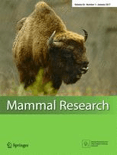
Mammal Research
Fostering Collaboration in Mammal Research ExcellenceMammal Research, published by Springer Heidelberg, is a prominent academic journal dedicated to advancing knowledge in the fields of Animal Science, Zoology, Ecology, Evolution, and Behavior. With an impressive Q2 ranking in both Animal Science and Zoology and Ecology, Evolution, Behavior and Systematics as of 2023, this journal is an essential resource for researchers and professionals seeking to publish innovative findings that contribute to our understanding of mammalian biology. The journal operates under an Open Access model, allowing a wide audience to access and engage with high-quality research articles. Converging between 2015 to 2024, Mammal Research serves as a vital platform for scholarly discourse, promoting rigorous scientific inquiry and collaboration among experts and students alike in the fascinating study of mammals.

JOURNAL OF ZOOLOGY
Fostering understanding of wildlife and ecological challenges.JOURNAL OF ZOOLOGY, published by Wiley, stands as a premier scholarly journal in the fields of Animal Science and Zoology, renowned for its outstanding contributions to the knowledge of animal biology and ecology. With an impressive impact factor and a strong ranking in the Q1 category for Animal Science and Zoology, as well as Q2 for Ecology, Evolution, Behavior, and Systematics, the journal rigorously engages with both foundational research and groundbreaking discoveries since its inception in 1830. Located in Hoboken, New Jersey, this journal is dedicated to fostering the academic community's understanding of zoological sciences, providing access to important research that shapes wildlife conservation efforts and ecological studies. Although the journal does not currently offer open access options, it continues to attract significant attention, as evidenced by its strong Scopus rankings in related categories. Researchers, professionals, and students will find invaluable resources in the JOURNAL OF ZOOLOGY to advance their understanding of animal life and the ecological challenges it faces today.
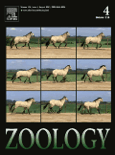
ZOOLOGY
Connecting scholars to elevate zoological research.ZOOLOGY, an esteemed journal published by Elsevier GmbH, stands at the forefront of research in the Animal Science and Zoology fields. With a notable impact factor and recognized as a Q1 category journal in its discipline, ZOOLOGY is highly regarded among researchers, ranking #98 out of 490 in Scopus rankings. Founded in 1994 and continuing through to 2024, the journal aims to publish cutting-edge, peer-reviewed articles that contribute significantly to the understanding of zoological sciences. Based in Munich, Germany, ZOOLOGY provides both subscription and open access options, ensuring that influential research reaches a wider audience. It serves as an essential platform for disseminating innovative findings, connecting scholars globally, and fostering interdisciplinary collaboration to advance zoological knowledge.
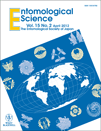
ENTOMOLOGICAL SCIENCE
Pioneering Research in Insect ScienceENTOMOLOGICAL SCIENCE, published by WILEY, stands at the forefront of research in the field of entomology, focusing on the intricate relationships between insects and their environments. With its ISSN 1343-8786 and E-ISSN 1479-8298, this esteemed journal, based in the United States, has been serving the scientific community since 2005. As a Q3 journal in both Ecology, Evolution, Behavior and Systematics and Insect Science, it presents vital peer-reviewed articles that advance our understanding of insects and their ecosystems. With a Scopus rank of 85/181 in Insect Science, the journal not only reinforces the importance of insect study but also serves as an essential resource for researchers and professionals seeking to explore and disseminate knowledge in this dynamic field. Although it does not offer Open Access options, its scholarly contributions are invaluable for those invested in ecological research and entomological perspectives—making it a must-read for aspiring and established scientists alike.
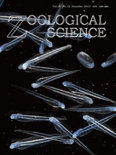
ZOOLOGICAL SCIENCE
Exploring the Wonders of ZoologyZoological Science, published by the Zoological Society of Japan, is a leading journal dedicated to the fields of animal science and zoology. With its ISSN 0289-0003, this respected publication has established itself as a prominent source of scientific research, attaining a commendable Q2 ranking in the 2023 category of Animal Science and Zoology. Spanning over three decades, from 1992 to 2024, the journal offers a valuable platform for scholarly articles that explore various aspects of zoology, including ecology, behavior, and evolutionary biology. Although it operates under a traditional subscription model, its contributions are supported by a robust community of researchers and professionals who value its insights. The journal strives to foster academic discourse and insights that drive understanding and conservation of wildlife, making it an essential resource for students and established experts alike. The publishing headquarters located in Tokyo, Japan, further enhances its international reach and influence in zoological studies.

Current Zoology
Pioneering Discoveries in the World of ZoologyCurrent Zoology, published by Oxford University Press, is a leading open-access journal dedicated to advancing the field of zoology and animal science since its establishment in 2009. With an impressive Q1 ranking in Animal Science and Zoology as of 2023, the journal maintains a prominent position within the academic community, supported by a ranking of #138 out of 490 in Scopus. Current Zoology serves as a vital platform for researchers, professionals, and students, showcasing high-quality research that spans a broad array of topics within the domain of zoology. This journal is characterized by its rigorous peer-review process, ensuring the dissemination of credible and impactful findings that contribute to the understanding of animal biology and conservation efforts. The open-access model enhances accessibility, allowing a wider audience to engage with the pivotal research being conducted in this dynamic field. Processing all manuscripts in an efficient manner and featuring articles that push the boundaries of current knowledge, Current Zoology is your gateway to explore innovative discoveries and trends in zoology.

Redia-Journal of Zoology
Fostering insights in ecology and conservation.Redia-Journal of Zoology, published by the CRA-Research Centre Agrobiology & Pedology in Italy, is a distinguished academic journal dedicated to advancing the field of zoological studies through high-quality research and insightful reviews. With an ISSN of 0370-4327, this journal provides a platform for scholars and practitioners in the Agricultural and Biological Sciences to disseminate their findings and engage in meaningful discourse. Recognized in the 2023 Scopus rankings as Q2 in its category, Redia occupies a notable position within the global research community, ranked 138 out of 221 in Agricultural and Biological Sciences. The journal has a commitment to publishing original research from 2011 until 2024, contributing to the body of knowledge in diverse sub-disciplines of zoology, ecology, and conservation. While currently not open access, Redia strives to foster collaboration and discussion among researchers, making it a vital resource for advancing zoological sciences.

CONTRIBUTIONS TO ZOOLOGY
Advancing the Frontiers of Animal ScienceCONTRIBUTIONS TO ZOOLOGY, published by BRILL, is a premier scholarly journal dedicated to advancing the field of zoological sciences. With an ISSN of 1383-4517 and an E-ISSN of 1875-9866, this journal serves as a vital platform for researchers, professionals, and students seeking to share their findings and insights related to animal science, ecology, evolution, and systematics. Recognized for its high academic standards, it ranks in the top quartile (Q1) for Animal Science and Zoology, and Q2 for Ecology, Evolution, Behavior, and Systematics, reflecting its significance and influence in the scholarly community. The journal has been consistently published since 1994 and continues to contribute pivotal knowledge that informs and shapes contemporary zoological research. Researchers can access the journal through traditional subscription models, ensuring broad dissemination of its impactful articles and studies. Contributions to Zoology plays an essential role in fostering collaboration and discussion within the zoological community in the Netherlands and beyond.

ZOOLOGICHESKY ZHURNAL
Delving into the dynamics of ecosystems and species behavior.Zoologichesky Zhurnal, a prominent journal in the field of Ecology, Evolution, Behavior and Systematics, has been a vital publication since its inception in 1950. Published by MAIK Nauka-Interperiodica in the Russian Federation, this journal has established a notable reputation in disseminating scientific research and advancing knowledge in zoology. With its coverage spanning from 1950 to 2023, and a specific convergent focus during 1982-1983, this journal contributes significantly to the ecological and evolutionary sciences, even though it currently holds a Q4 classification in the 2023 category quartiles, indicating its niche positioning among peers. Researchers and students engaged in the study of biological sciences, particularly those interested in the dynamics of ecosystems, behavior of species, and evolutionary processes, will find valuable insights and original research articles within its pages. While access to this esteemed journal is not open, it remains an essential resource for those seeking to deepen their understanding of zoological sciences.

RUSSIAN JOURNAL OF THERIOLOGY
Pioneering Research in Ecology and SystematicsRUSSIAN JOURNAL OF THERIOLOGY is a prominent academic journal published by KMK SCIENTIFIC PRESS LTD in collaboration with the esteemed Moscow State University. As a dedicated platform for researchers in the fields of Animal Science and Zoology, Ecology, Evolution, Behavior and Systematics, and Plant Science, this journal strives to advance our understanding of terrestrial ecosystems and their inhabitants. Although it currently holds a Q4 ranking and ranks within the lower percentiles of its respective categories, the journal's consistent publishing output since 2011 showcases a commitment to facilitating scientific discourse and collaboration. Addressed to a diverse audience of researchers, professionals, and students, RUSSIAN JOURNAL OF THERIOLOGY serves as an essential resource for disseminating valuable insights and fostering future advancements in the biological sciences.